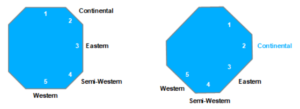Learn to serve
In 5 steps to the perfect tennis serve as a beginner
In 5 steps to the perfect tennis serve as a beginner
The serve opens the game in tennis and often decides whether you win or lose. A good serve puts you in a promising position for the next shot. A weak serve, on the other hand, puts you directly on the defensive.
You always have two attempts to bring the serve into play: the 1st and 2nd serve. With the 1st serve you can take a higher risk, while the 2nd serve should be played safely – but not too defensively – into the court. A good serve is also a real weapon in doubles, as it allows you to put your opponents under pressure early on.
It is therefore worthwhile to put some practice time into the serve. Below we explain to tennis beginners the 5 steps to the perfect tennis serve: from the serve grip, the backswing, the movement and the outswing to serving tips.
1. Tennis grip to serve
Since a tennis serve opens the rally, you are not in a hurry to prepare. Nevertheless, it is crucial to choose the right service grip, because it allows you to play different technical variations: from the slice serve to the straight serve to the kick serve.
You stand either on the left or right half of the court behind the baseline and serve the tennis ball diagonally into the T-field. As with the volley, the so-called Continental grip can be used for any type of serve. The Continental grip allows you to give the tennis ball a different spin depending on the ball toss and thus be as flexible as possible.

2. Tennis backswing
You stand behind the baseline and are turned sideways to the net. As a right-handed player, your left foot is roughly parallel to the baseline. It is important that you do not stand with your foot on the baseline when the tennis ball is hit: this would be a foot fault, which is equivalent to hitting the ball out.
The upper body is also turned sideways to the net and you stand with your legs wide and comfortable. This starting position gives you a stable stance for the serve.
As a right-handed player, the tennis ball is in your left hand. Many players bounce the ball on the ground again to be able to concentrate fully on the serve.
You bring the tennis racket in front of your body and the tennis ball and the tennis racket touch each other with outstretched arms. The tip of the racket points in the direction of the service court and off you go: you drop the tennis racket from the front downwards while the arm remains stretched. You swing the racket back up from the net in the opposite direction.
Both arms are still extended and go parallel – with the open palms – upwards. The weight is shifted to the back foot at the same time.
Then toss the tennis ball into the air with an outstretched arm while the arm with the tennis racket bends so that the tennis racket feels like it is being put into an imaginary backpack. The hand without the racket remains directed upward toward the ball and stabilizes your movement. In addition, you bend your knees on both sides – a little lower on the back foot.
3. Tennis movement
For the perfect movement of the serve, the hitting arm is then accelerated upwards and you hit the ball as it falls down – not as it rises – in full extension and thus at the highest possible point in front of the body. The hand directed at the ball is at that moment already on the way down again.
Your weight is shifted forward from the back foot through complete knee extension to get even more power out of the serve. Shortly before the point of impact of the tennis ball, additionally snap your hitting arm wrist downwards, so that a little extra power is mobilized here as well.
4. Tennis outswing
For the outswing of the serve, continue the natural motion sequence: swing the tennis racket down past the other side of your body and take the 2nd hand back to the racket handle and move to the center of the court or starting position.
Again, note that both the backswing, motion sequence and outswing is a fluid motion.
5. Typical service mistakes and tips
Finally, three typical mistakes and tips to improve your serve:
a) A good ball toss is half the battle
The most common mistake made by tennis beginners is not tossing the ball well and trying to hit it anyway, sometimes with the ball wandering behind. It is better to let the tennis ball bounce again and execute the serve again – an executed ball toss is not a mistake – a hit ball is.
Note that a good ball toss for right-handers should come up slightly right in front of your body. For left-handers, it should come slightly to the left in front of your body.
b) Make sure you swing the tennis racket to the side of your body
To prevent injuries, it is important to swing the tennis racket to the side of the body. Some tennis beginners are so focused on the tennis ball that their own shins have to take the brunt of the swing. Therefore, be sure to do a lot of dry practice to learn the proper outswing as well.
c) The net is lowest in the middle
When placing the serve, tennis players talk about serving to the outside, to the body (of the opponent) or through the middle. The advantage of serving through the middle is that the ball travels the shortest distance and the net is lowest, so the serve achieves the highest speed.

